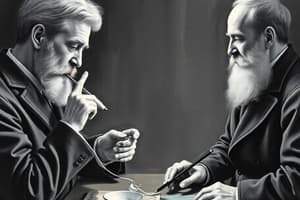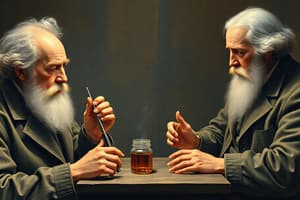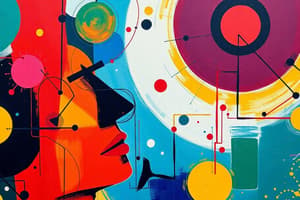Podcast
Questions and Answers
What significant concept is associated with Ivan Pavlov's findings on dogs?
What significant concept is associated with Ivan Pavlov's findings on dogs?
- Relativity theory
- Classical conditioning (correct)
- Thermodynamics
- Quantum entanglement
Which of the following was NOT a contribution made by Wilhelm Röntgen?
Which of the following was NOT a contribution made by Wilhelm Röntgen?
- Development of serum therapy (correct)
- Studies in heat and electricity
- Discovery of X-rays
- Innovations in mechanics
What principle did Kitasato Shibasaburo demonstrate with his tetanus serum?
What principle did Kitasato Shibasaburo demonstrate with his tetanus serum?
- Vaccination theory
- Cellular respiration
- Antibody formation (correct)
- Homeostasis
What aspect of chaos theory did Henri Poincaré's findings reveal?
What aspect of chaos theory did Henri Poincaré's findings reveal?
In what year did Wilhelm Röntgen discover X-rays?
In what year did Wilhelm Röntgen discover X-rays?
What motivated Röntgen to bequeath his Nobel Prize money?
What motivated Röntgen to bequeath his Nobel Prize money?
Which major disease was Kitasato Shibasaburo's serum therapy NOT designed to protect against?
Which major disease was Kitasato Shibasaburo's serum therapy NOT designed to protect against?
Which award did Ivan Pavlov receive for his work in physiology?
Which award did Ivan Pavlov receive for his work in physiology?
Which discovery is J.J. Thomson credited with that significantly changed atomic theory?
Which discovery is J.J. Thomson credited with that significantly changed atomic theory?
What significant idea about climate change did Svante Arrhenius propose?
What significant idea about climate change did Svante Arrhenius propose?
What pattern did Henrietta Swan Leavitt discover in Cepheid variable stars?
What pattern did Henrietta Swan Leavitt discover in Cepheid variable stars?
What was Harriet Brooks' key contribution to nuclear physics?
What was Harriet Brooks' key contribution to nuclear physics?
Which observational contribution did Annie Jump Cannon make to astronomy?
Which observational contribution did Annie Jump Cannon make to astronomy?
What was the primary focus of Srinivasa Ramanujan's work despite his lack of formal training?
What was the primary focus of Srinivasa Ramanujan's work despite his lack of formal training?
What equation did Erwin Schrödinger develop that transformed our understanding of electrons?
What equation did Erwin Schrödinger develop that transformed our understanding of electrons?
How did Ronald Fisher reconcile the ideas of Darwin and Mendel?
How did Ronald Fisher reconcile the ideas of Darwin and Mendel?
What experiment did Harold Urey and Stanley Miller conduct in 1953?
What experiment did Harold Urey and Stanley Miller conduct in 1953?
Which concept best describes J.J. Thomson's plum pudding model?
Which concept best describes J.J. Thomson's plum pudding model?
What was a characteristic feature of Henrietta Swan Leavitt's methods at the Harvard Observatory?
What was a characteristic feature of Henrietta Swan Leavitt's methods at the Harvard Observatory?
Which significant outcome followed Schrödinger's wave mechanics?
Which significant outcome followed Schrödinger's wave mechanics?
What theory did Svante Arrhenius challenge regarding Earth’s ancient climate?
What theory did Svante Arrhenius challenge regarding Earth’s ancient climate?
In which area did Ronald Fisher make a pioneering impact?
In which area did Ronald Fisher make a pioneering impact?
Flashcards are hidden until you start studying
Study Notes
19th Century Science and Progress
- Science became closely associated with progress by the turn of the 19th century.
20th Century Scientific Breakthroughs
- Significant advancements in fundamental ideas occurred in the 20th century, driven by cutting-edge research.
- Discoveries were abundant, rewriting knowledge about subatomic and cosmological levels.
Wilhelm Conrad Röntgen
- German physicist who discovered X-rays in 1895.
- Discovered that electrically charged vacuum tubes emitted rays that made a fluorescent screen glow.
- These electromagnetic rays could penetrate human skin to expose photographic plates but were blocked by metal and bone.
- Awarded the first Nobel Prize in Physics in 1901.
- He never patented the X-ray and donated his prize money to scientific research.
- Also known for his contributions to mechanics, heat, and electricity.
Kitasato Shibasaburo
- Japanese physician and bacteriologist who studied in Tokyo and Berlin.
- Developed serum therapy to protect against tetanus and diphtheria.
- In 1890, he discovered that injections of tetanus serum containing antitoxin from an animal exposed to tetanus bacteria conferred immunity.
- Applied the same principle to protect against diphtheria.
Ivan Pavlov
- Russian-born scientist who transitioned from a religious career to physiology.
- Became a professor at the Military Medical Academy in St. Petersburg in 1890.
- Studied digestive secretions in dogs and discovered classical conditioning.
- Dogs learned to associate the sound of a bell with food, eventually salivating even without food present.
- This discovery is now known as Pavlovian conditioning.
- Won the Nobel Prize in Physiology or Medicine in 1904 for his groundbreaking work.
Jules Henri Poincaré
- French mathematical physicist who studied the stability of the solar system.
- Noticed that even tiny changes in initial conditions could lead to significant and unpredictable changes in outcomes (chaotic behavior).
- These findings, published as early as 1908, formed the basis for chaos theory.
- His work on electromagnetism influenced Einstein's research on relativity.
J.J. Thomson
- English physicist who made significant contributions to understanding atomic structure.
- Identified "corpuscles" (later called electrons) using a cathode ray tube.
- Showed that electrons have a negative electric charge and are 2,000 times lighter than a hydrogen atom.
- Proposed the "plum pudding model" of the atom, suggesting that a positive charge is spread throughout with electrons embedded within.
- His discoveries revolutionized theories of atoms and electricity.
- He also confirmed the existence of isotopes.
Svante Arrhenius
- Swedish physicist who studied at the University of Uppsala.
- Became a professor of physics at the University of Stockholm.
- In the 1890s, he theorized that ice ages were caused by reduced volcanic eruptions.
- Fewer eruptions would lead to lower carbon dioxide levels, cooling the Earth.
- He linked human activity (fossil fuel burning) to increased carbon dioxide and rising global temperatures, laying the groundwork for modern climate change concerns.
Henrietta Swan Leavitt
- American astronomer who studied at Radcliffe College.
- Worked at the Harvard College Observatory, analyzing the luminosity of stars from photographic plates.
- Discovered a regular pattern of brightness in Cepheid variable stars.
- Her work was instrumental in measuring the distance between Earth and other galaxies.
- Discovered over 2,400 variable stars and four novae.
- Developed a standard for photographic measurements called the Harvard Standard.
- Her contributions were largely underappreciated during her lifetime.
Harriet Brooks
- Canadian physicist who graduated from McGill University.
- Became Canada's first female nuclear physicist.
- Studied under J.J. Thomson and Ernest Rutherford, working in Marie Curie's laboratory.
- Discovered that nuclear decay can lead to the transformation of one element into another.
- Some of her findings were only attributed to her posthumously.
Annie Jump Cannon
- American astronomer who became a leading authority on stellar spectra.
- Studied physics and astronomy at Wellesley College.
- Joined the Harvard College Observatory in 1896, classifying stars.
- Pioneered a star classification system in 1901, laying the foundation for the Harvard Spectral Classification system.
- Classified over 350,000 stars during her 44 years at the observatory.
Srinivasa Ramanujan
- Indian mathematician who made significant contributions to mathematical analysis and number theory.
- Received little formal training.
- Invited to Cambridge in 1913 after sending mathematician G.H. Hardy a letter and 120 mathematical theorems.
- Awarded a Bachelor of Science degree in 1916 and became the second Indian fellow of the Royal Society.
- Sadly, he died of tuberculosis in 1920.
Erwin Schrödinger
-
Austrian physicist who studied at the University of Vienna.
-
Made groundbreaking contributions to quantum physics while working at the University of Zurich.
-
Developed the Schrödinger wave equation, offering a new understanding of particle behavior.
-
This equation showed that orbitals, shells, and subshells are probability clouds representing the likelihood of an electron's location.
-
His equations of wave mechanics revolutionized our understanding of the world and formed the basis for modern quantum mechanics.
Ronald Fisher
-
British statistician and geneticist who pioneered the use of statistics in scientific experimentation.
-
In 1918, he published a paper highlighting the application of statistical tools to reconcile Darwin's theory of natural selection with Mendel's experiments.
-
Knighted in 1952 for his contributions to science.
Harold Urey and Stanley Miller
- American chemists who conducted a landmark experiment in 1953.
- Simulated Earth's early atmosphere in the laboratory using electrical sparks to mimic lightning.
- Their experiment showed that simple carbon-based compounds, essential for life, could be produced under such conditions.
Studying That Suits You
Use AI to generate personalized quizzes and flashcards to suit your learning preferences.





